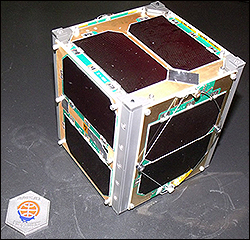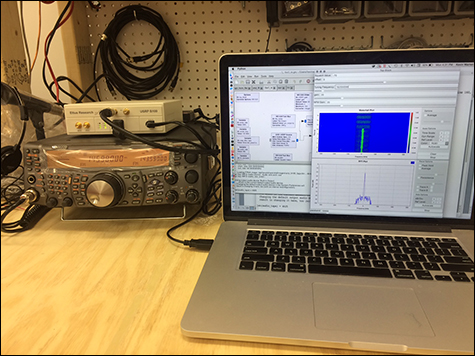Building a program of reliable CubeSats; doing real science at a fraction of the cost
A tiny space hitchhiker named AO-85 is talking and thousands of ham radio operators worldwide and a handful of Vanderbilt University engineering researchers with the special interest of proud parents are listening.
AO-85’s transponder was turned on three days after the 4-inch by 4-inch, 2.2 pound CubeSat successfully deployed from an Atlas V rocket launched (video) by the United Launch Alliance in October from Vandenberg Air Force Base in California.

“When the deployment was successful and the beacon came on we had an ‘It’s alive!’ moment,” said Robert Reed, professor of electrical engineering and the principal investigator of Vanderbilt’s NASA-sponsored CubeSat project. “Then, the transmitter was turned on and we had a data stream sufficient to collect information to do research.”
In reality, a successful deployment and a successful data transmission is somewhat rare in university CubeSat programs, giving the researchers reason enough for celebration.
The Vanderbilt project, however, differs from CubeSat efforts at other universities in an important way.

“Our effort was conceived for, proposed for, and has been conducted as basic engineering research,” said Robert Weller, professor of electrical engineering and co-PI. “In fact, ours is unusual among university CubeSat programs in that it was conceived and executed for scientific objectives as opposed to solely for undergraduate education.”
Engineers at Vanderbilt’s Institute for Space and Defense Electronics (ISDE) and student researchers are collecting data from their payload experiment on AO-85 to test the reliability and survivability of advanced semiconductor components in the harsh radiation environment of space.

The ISDE team fabricated a single test bed (SRAM cards) using commercially available components worth about $200. They are modeling the radiation exposure and testing key components for radiation sensitivity, which will help them design electronics systems for greater fault tolerance.
Specifically, they are making real time measurements of radiation-induced failures called single-event upsets (SEUs) and conducting extensive computer simulations of the performance of the electronics using unique software developed at Vanderbilt over the last decade.
Ears around the world
The Vanderbilt data are being received by thousands of ham radio operators worldwide, a unique distinction made possible by a partnership with the Radio Amateur Satellite Corporation. AMSAT, a volunteer organization of ham radio operators that has been building and launching satellites since the 1960s, provided Vanderbilt with a seat on the “spacecraft bus” and is collecting and feeding the telemetry to the university via the Internet.

The CubeSat’s high data rate transmitter is fully operational for amateur radio use, including two ISDE ground stations, with a third now being built by engineering undergraduates. There is a nominal mission target of one year, but telemetry will be available until AO-85 fails or burns up upon reentry into Earth’s atmosphere, which is expected to be in about nine years.
CubeSats, once just a cheap way for university students to build and launch a satellite, have become one of the hottest new technologies in the space industry. Now, the NASA program (ELaNa) that offers free launches to education and encourages science missions, is open to U.S. non-profit corporations like AMSAT.
Project Fox is AMSAT’s answer to this new, emerging technology. AMSAT is developing a family of CubeSats with amateur radio transponders that support advanced science experiments and AO-85 is AMSAT’s first generation CubeSat that has resulted from the Fox project.

“A key advantage is that the Vanderbilt/AMSAT team is building a program of reliable CubeSats,” according to Reed. “And, we’re able to do real science.”
“The spacecraft and predictive models are all working as planned,” said Reed in a team meeting at ISDE headquarters. “It’s incredibly boring,” he said, prompting laughter from team members Rebekah Austin and James Trippe, electrical engineering graduate students; and research engineers Brian Sierawski, Andrew Sternberg and Kevin Warren, who has set up a ground station in his garage. Warren, Sternberg, Austin, and Professor Weller all have ham radio licenses.
Space weather damage
Space weather phenomena have a variety of effects on technology. Component failures can result from space weather in low-earth orbit – cosmic rays, solar wind, and from solar flares and coronal mass ejections, which emit different things, look and travel differently, and they have different effects.
“Spacecraft electronics can be damaged, radio waves used for satellite communications or GPS navigation are affected, even earth’s power systems can experience outages,” said Warren.

“In the case of spacecraft electronics, this is important work. In most cases, radiation ‘transport’ through Earth’s magnetic field causes an erroneous signal or changes one bit in memory of a spacecraft’s electronics (SEUs). In a few cases, the radiation destroys a section of the electronics (single-event latchup),” said Brian Sierawski.
Reliability is a key issue faced by NASA and other agencies as they move toward implementing the CubeSat framework for space science applications.
“The small form factor of CubeSats forces spacecraft designers to use unconventional components that have not been qualified for space applications, pushing the costs of the CubeSat well beyond the $10 million mark. The success of AO-85 demonstrates that it is possible to build a reliable spacecraft for a fraction of that cost,” said Reed.
The Vanderbilt-AMSAT team will launch several additional CubeSats over the next few months and years, confirming again that at Vanderbilt science is fun, and in amateur radio, fun can be science.
Contact:
Brenda Ellis, (615) 343-6314
Brenda.Ellis@Vanderbilt.edu
Twitter @VUEngineering